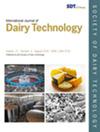Impact of spray drying temperatures on whey protein concentrate particle size, particle shape and related powder physical properties
Abstract
Background, Context, or Rationale
Whey protein concentrate (WPC) powders are widely used as ingredients in the food industry due to their high-protein content and desirable functional properties. Sub-optimal spray drying conditions can lead to poor powder flowability and/or increased cohesiveness, influencing the risk of handling challenges.
Aims
This study investigates the impact of varying spray drying temperatures and powder storage temperatures on particle size distribution, particle shape, cohesiveness and flowability of WPC80 powders.
Methods
Liquid WPC was spray-dried at three different inlet/outlet temperature combinations: lower (180°C/77°C), moderate (197°C/94°C) and higher (214°C/111°C). The powders were then stored at 20°C, 30°C or 40°C for 61 days. Flowability and cohesiveness were measured using the Carr Index and Warren–Spring cohesion, respectively. Particle morphology was analysed using dynamic image analysis (DIA), laser diffraction and scanning electron microscopy (SEM).
Major Findings
This study demonstrated that moderate and higher spray drying temperatures yielded smaller, more irregularly shaped particles with reduced flowability, compared to WPC spray-dried at lower temperatures. This was related to particle breakage, lower bulk density and increased compressibility. Lower spray drying temperatures yielded larger, more uniformly shaped particles with better flowability but higher levels of residual moisture and water activity, and more cohesive compressed powder. This study demonstrates that storage temperatures have a negligible effect on particle morphology and flowability, with only a limited influence on the cohesion of WPC powder. These findings are mainly attributed to the way storage temperature affects moisture availability, which can result in liquid bridging between WPC particles.
Scientific or Industrial Implications
Optimising spray drying temperatures can improve the physical properties of WPC80 powders, enhancing their handling behaviour by influencing particle morphology and particle–particle interactions. Future research should explore the roles of nonenzymatic browning and particle shape of WPC80 powder particles on rehydration properties.


 求助内容:
求助内容: 应助结果提醒方式:
应助结果提醒方式:


